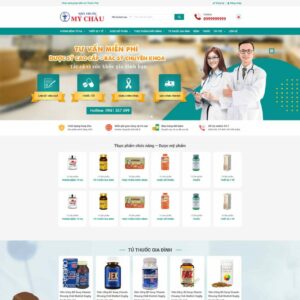
Ecomkey’s probiotics website features a premium WordPress theme with intuitive navigation and clear product info, offering natural wellness solutions effectively.
The beautiful and SEO-friendly functional food WordPress theme at Themewpgiare.com helps businesses create a professional and effective website for the sales industry.
The WordPress theme Pharmacy 02 helps you build a modern healthcare website, attracting customers with professional features and a diverse catalog.
The WordPress theme for Pharmacy 8 is optimized for mobile experience and effective SEO support, helping to improve rankings and attract customers.
WordPress theme supporting the categories of Business, Food, and Health, optimized for cough syrup, with a user-friendly interface that is easy to use.
Discover a professional health course landing page template, effective for advertising, helping you attract students and increase revenue.
WordPress Theme for Selling Pharmaceuticals Year 02 with categories for Sales, Functional Foods, Health and Medicine, optimized for revenue.
The WordPress pharmaceutical theme 1 is ideal for businesses and clinics in the healthcare sector, easily customizable and optimized for SEO.
The WordPress pharmaceutical theme 4 is ideal for health and medical news websites, user-friendly, SEO optimized, and enhances the user experience.
The WordPress pharmacy theme 7 features a professional, user-friendly interface optimized for easy information searching and shopping.
The WordPress theme for acupuncture clinics helps you create a professional website that attracts customers with an excellent experience. It serves the healthcare and business sectors.
The WordPress theme for introducing an organic milk company is the perfect choice for natural dairy businesses, attracting customers with Sales and Health categories.
1. Why is Designing a Professional Healthcare Website Necessary?
In the digital age, the demand for online health information is increasing. A professional healthcare website not only allows hospitals and clinics to provide information quickly and accurately but also bridges the gap with patients, enhancing trust and credibility. An SEO-friendly website helps hospitals and clinics reach the right audience, supporting the promotion of services and comprehensive community healthcare.
2. Essential Features for a Healthcare Website
To build a friendly and professional healthcare website, it is necessary to integrate key features that meet the needs of both patients and healthcare facilities. The healthcare website should have a simple, user-friendly interface with a clear layout. Additionally, it should focus on displaying health information, services, and health consultations in an easily understandable manner. Professional design fosters trust and provides the best user experience.
2.1. Detailed Health Service Information
Provide detailed information about medical services, treatments, health consultations, and the medical staff. This allows patients to easily access and understand the services available, making informed choices.
2.2. Online Appointment Booking
The online appointment booking feature is essential. It enables patients to proactively schedule their appointments, reducing wait times and optimizing the treatment process. Through this system, hospitals and clinics can efficiently manage appointment schedules.
2.3. Online Consultation Section
Online consultations help patients address their queries and receive timely support from specialists. This feature not only increases interaction but also enhances the quality of healthcare services.
3. SEO Standard Design Process for Healthcare Websites
Designing an SEO-friendly healthcare website is crucial for ensuring that your website can easily reach patients through search engines. A standardized design process will enhance the website’s functionality and build user trust.
The first step is to identify the goals of the website and the target patient audience. Next, research keywords such as “healthcare website design,” “online health services,” and “health consultation” to optimize the content. From there, create a user-friendly interface focusing on user experience.
3.1. Building Quality Content
Content is a key factor. Draft detailed content about health services, health knowledge, medical staff, and healthcare news. The content must be clear, useful, and incorporate relevant keywords naturally while avoiding keyword stuffing.
3.2. On-Page SEO Optimization
Optimize SEO elements such as title tags, meta descriptions, headings, and URLs. ALT tags of images should include relevant keywords, and internal links should be created to enhance connectivity between pages on the website.
3.3. Testing and Evaluation
Before the website officially launches, check loading speed, appointment booking features, and compatibility across all devices. Re-evaluate content and layout to ensure SEO compliance and user-friendliness.
4. Benefits of Owning an SEO-Friendly Healthcare Website
An SEO-friendly healthcare website offers many benefits to hospitals and clinics in reaching and caring for patients.
- Increased Patient Reach: An SEO-friendly website helps healthcare facilities appear easily on the first page of search results, attracting a large number of potential patients.
- Quick Information Delivery: Provides timely health information, services, and news. This helps patients easily grasp and choose suitable services.
- Enhanced Credibility: A professional healthcare website helps hospitals and clinics establish credibility and trust with patients, creating a brand presence in the healthcare field.
- Cost Savings: The online appointment feature helps reduce personnel costs, optimizing operations and patient care processes.
5. Modern Trends in Healthcare Website Design
In 2024, healthcare website design trends focus on user experience, optimizing features, and interface design.
5.1. Minimalist, User-Friendly Interface
A minimalist design that emphasizes a clear layout and soft colors helps patients easily find information without feeling overwhelmed. Presenting information in an organized manner enhances user experience.
5.2. Integration of Consultation Chatbots
Online consultation chatbots quickly address patient queries, assist with appointment bookings, and provide service information. This feature increases interaction and enhances customer care quality.
5.3. Responsive Design
The website should be responsive, compatible with all devices from computers to smartphones and tablets, allowing patients to access information and services anytime, anywhere.
6. Choosing a Reputable Healthcare Website Design Agency
To achieve a professional healthcare website, businesses should choose a reputable design agency experienced in the healthcare field. This agency should offer comprehensive design, programming, and SEO optimization services, ensuring the website operates effectively, safely, and attracts patients.
Conclusion
Designing a professional healthcare website is a crucial step for hospitals and clinics to reach patients, provide effective healthcare services, and enhance credibility. Invest in an SEO-friendly website design today to establish your position in the healthcare field.
Related Keywords:
- Healthcare website design
- Health service website
- Clinic website design
- Healthcare website design services











